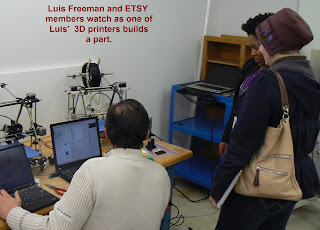 Hey guys, wow...what an exciting Tuesday! My happiness is still buzzing from earlier this week when Luis brought in all his 3D printers. So much fun! I loved to see everyone visit and test out the models. You can really feel the excitement in the crowd as everyone suddenly realizes how fast these babies print.
Hey guys, wow...what an exciting Tuesday! My happiness is still buzzing from earlier this week when Luis brought in all his 3D printers. So much fun! I loved to see everyone visit and test out the models. You can really feel the excitement in the crowd as everyone suddenly realizes how fast these babies print.
There's something magical about designing something in a CAD program on the computer in a few minutes and seeing it grow right before your eyes. While there are a LOT of different uses for these, my favorite one of the night was by Rachel Pollock with the UNC Grad Design Program. She used one of the printers to print out custom new feet for her hat-sizer from the mid-1850s. Besides making a lot of her students very happy, it was the kind of practical application I had not considered that 3D printers will enable you to refurbish or fix old machines by making parts for them that no longer exist. You can see her here chatting with Luis as they go over the design. She made the feet in the computer labs using AutoInventor in a few minutes apparently and it worked just fine with only 1 minor adjustment off the bat. Let's hear it for us normal designers who don't spend our days trapped being a screen on solid works.
We all know I'm getting mine to print custom zippers, buttons, and hardware, but it's mind-blowing how many different applications 3D printers have that was not readily apparent to me at the beginning. I can't wait to see what's made.
 A reminder to everyone else, if you have not used a 3D printer before, openscad is compatible with any major CAD software program and freely available off the internet. STL files are particularly easy to use with it. If you would like design something small (2 inch cube or smaller) over the next few weeks and bring the file in to the next meeting on the 21st, Luis will again be on hand to demonstrate and print out parts. As you can see we have a BUNCH of machines so we can print multiple items at once. They're remarkably stable compared to the versions I've seen commonly available a couple years back so you can put 3-4 on one table and have them going at the same time.
A reminder to everyone else, if you have not used a 3D printer before, openscad is compatible with any major CAD software program and freely available off the internet. STL files are particularly easy to use with it. If you would like design something small (2 inch cube or smaller) over the next few weeks and bring the file in to the next meeting on the 21st, Luis will again be on hand to demonstrate and print out parts. As you can see we have a BUNCH of machines so we can print multiple items at once. They're remarkably stable compared to the versions I've seen commonly available a couple years back so you can put 3-4 on one table and have them going at the same time. 
Common printing resolution is 0.4 mmm layers, but you can go do to 0.1 mm layers for resolution if you need fine parts detail for engine blocks and rotating parts. Please, come test these out in person. Luis has a bunch of different ABS plastic colors for you to print with sitting in different machines. You'll love it.
Have a great day everyone and see ya back tomorrow.
PS- All photos are complimentary of Rye Dewalt. Nice to have a fellow guest blogger back this week helping out.
I would like to know which skill the majority of mechanical engineering employers would find more appealing in a candidate. Knowledge in manufacturing & CNC processes or SolidWorks?.
ReplyDeletesolidworks support
Well, I like Solid Works, we use it a lot on Lectra cutting machines. However, I think you are confusing knowledge of a computer program vs. actual wisdom from on the job experience. Wisdom wins any day of the week. CNC is the type of thing that's a throw away skill, no employer is going to hire based on something that you can essentially train someone to use in 2 weeks on the job and often doesn't even lead to product savings. Hell, I know plenty of employers that will hire a cheap college grad as an assistant for a master just to digitize their designs if necessary. And often, they still throw that shit out at the end of the day. At last check in my business less than 2% of all employers require it in the hiring process. 85% don't even use CNC design in the manufacturing process. Good ideas that sell and make money are the most important thing, not CNC technology. It's not that it's not used, but it's a tool. And tools are not people.
ReplyDeleteEmployers hire people at the end of the day and buy equipment. SolidWorks and all CNC technology have three major flaws that are preventing widespread acceptance and until they are addressed, there's a huge market share that Solid Works and all CNC programs are missing out on. The answer which is apparent since the 1980s, seems essentially ignored by software companies. Hope that's helpful. Best of luck. Love using your computer program, wish it was more practical.